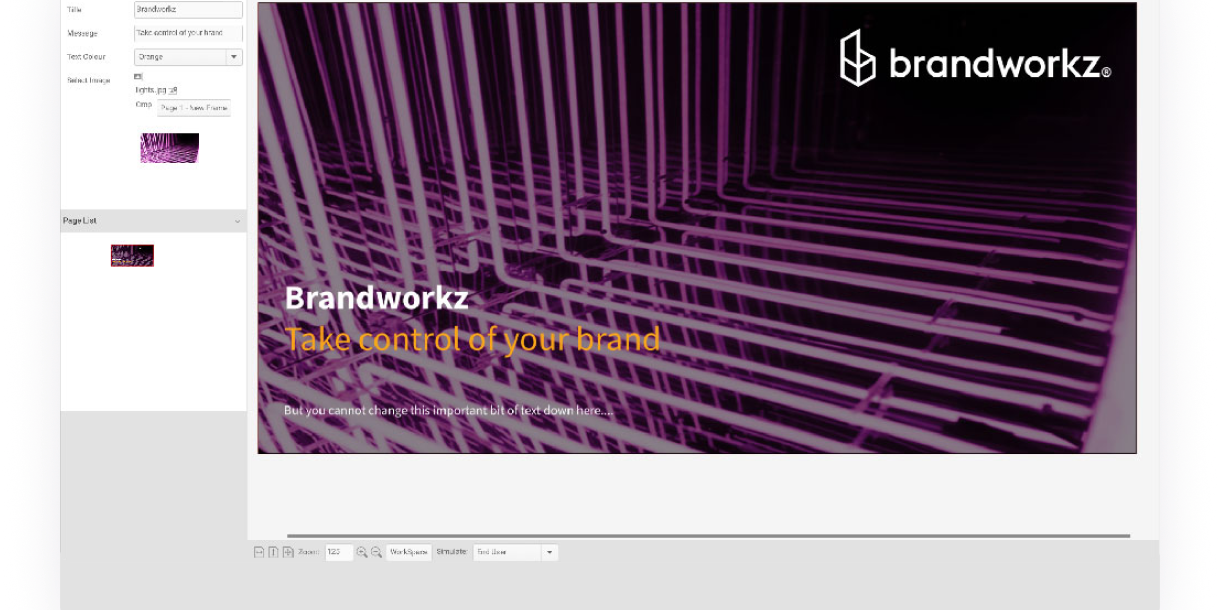In today’s fast-paced business environment, where brand consistency and speed to market are critical, companies need tools to create high-quality, on-brand content quickly and efficiently. Brandworkz’s dynamic templating capabilities offer a powerful solution to this challenge, allowing teams to produce customizable content that adheres to brand guidelines while reducing time and costs.
What Are Dynamic Templates?
Dynamic templates are pre-designed, customizable content formats that allow users to create brand-compliant materials without needing advanced design skills. They are built within the Brandworkz platform and designed to maintain a consistent look and feel across all marketing collateral, from digital ads and social media posts to brochures and presentations.
The power of dynamic templates lies in their flexibility. While the core design elements—such as logos, fonts, and colors—are locked to ensure brand consistency, users can easily modify other aspects of the content, such as text, images, and layout variations, to suit specific needs. This capability empowers marketing teams to produce a wide range of on-brand content quickly and efficiently without compromising quality or consistency.
Speed and Efficiency: Reducing Time to Market
One of the most significant benefits of Brandworkz’s dynamic templating capabilities is the dramatically reduced time required to create and distribute marketing materials. In traditional content creation workflows, marketers often rely on designers or external agencies to produce branded assets. This process can be time-consuming, requiring multiple revisions and approvals, which can delay campaigns and reduce agility.
With dynamic templates, the process is streamlined. Marketing teams can quickly generate content in-house by selecting a template, customizing it to meet their specific needs, and immediately deploying it across multiple channels. This speed to market is valuable in fast-moving industries where timely communication is essential for maintaining a competitive edge. By reducing the time it takes to create and distribute content, businesses can respond more quickly to market opportunities, seasonal trends, and customer needs, leading to increased engagement and better overall campaign performance.
Cost Efficiency: Saving Resources
In addition to saving time, dynamic templates also reduce costs associated with content creation. Companies can significantly reduce design and production expenses by enabling internal teams to produce branded materials without relying heavily on external resources. This cost efficiency is especially important for organizations that operate on tight marketing budgets or that need to produce large volumes of content across different regions and languages.
Moreover, the reusable nature of dynamic templates means that companies can create a library of templates for various purposes—such as product launches, events, and seasonal promotions—that can be easily adapted for future use. Reusing templates reduces the need to start from scratch for every new campaign, saving time and money.
Enhancing Brand Consistency
Brand consistency is critical to building and maintaining a solid brand identity. When customers encounter a brand, they expect a certain level of uniformity in the messaging, visuals, and overall experience. Inconsistent branding can lead to confusion, reduce brand trust, and weaken the brand’s position in the market.
Brandworkz’s dynamic templating capabilities ensure that all content created within the platform adheres to the company’s brand guidelines. By locking down critical design elements such as logos, fonts, and colors, dynamic templates prevent users from making unauthorized changes that could compromise brand integrity. At the same time, the flexibility to customize other aspects of the template allows for creativity and adaptation to different contexts and audiences.
This balance between consistency and flexibility is crucial for organizations that must maintain a cohesive brand image while catering to diverse markets and customer segments. Whether it’s a social media post targeted at millennials or a corporate presentation for investors, dynamic templates ensure every piece of content is unmistakably on-brand.
Improving Collaboration and Workflow
Dynamic templates also enhance collaboration between different teams within an organization. With all templates stored in a central location within the Brandworkz platform, marketing, design, and compliance teams can easily access, review, and approve content before it goes live. This centralized approach reduces the risk of miscommunication and ensures all stakeholders align with the brand’s objectives.
Furthermore, because dynamic templates are easy to use, they empower non-designers to contribute to content creation, allowing marketing teams to scale their efforts without overburdening the design team. This democratization of content creation increases productivity and fosters a more collaborative and agile marketing environment.
Boosting ROI: The Bottom Line
The ultimate goal of any marketing initiative is to deliver a strong return on investment. Brandworkz’s dynamic templating capabilities directly contribute to a higher ROI for marketing campaigns by reducing time to market, cutting costs, enhancing brand consistency, and improving collaboration.
Faster content creation means businesses can capitalize on market opportunities more quickly, while cost savings from reduced reliance on external resources free up the budget for other strategic initiatives. Consistent branding builds customer trust and loyalty, strengthening brand equity and long-term business growth.
In conclusion, Brandworkz’s dynamic templating capabilities offer a powerful tool for businesses looking to optimize their marketing efforts. By streamlining content creation, ensuring brand consistency, and driving cost efficiency, dynamic templates improve operational efficiency and deliver measurable results that boost ROI. For organizations serious about maximizing their brand’s impact, investing in dynamic templating is a strategic move that pays dividends in the long run.






